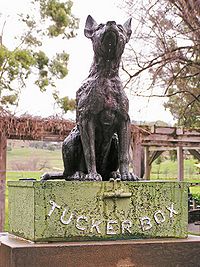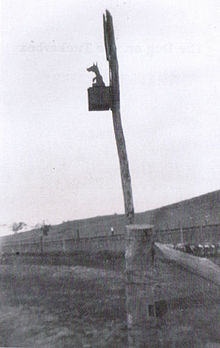| Revision as of 22:40, 26 July 2006 editMatilda (talk | contribs)Extended confirmed users22,816 edits move info about inscription, add info from Butcher's book; request citation of sources; correct apostrophe use; fmt inscription; 5 mile chosen deliberately not so much matter for controversy← Previous edit | Revision as of 23:27, 26 July 2006 edit undoMatilda (talk | contribs)Extended confirmed users22,816 edits wikilink Fitzpatrick - one of the founders of the Australian Council for Civil Liberties, an author and historianNext edit → | ||
| Line 12: | Line 12: | ||
| The Back to Gundagai Committee had chosen the Five Mile camping site rather than the Nine Mile Peg as a location for the monument on the basis that it was more convenient to the ] and closer to the town, thereby more beneficial to tourism.<ref name ="Butcher212-3"/> | The Back to Gundagai Committee had chosen the Five Mile camping site rather than the Nine Mile Peg as a location for the monument on the basis that it was more convenient to the ] and closer to the town, thereby more beneficial to tourism.<ref name ="Butcher212-3"/> | ||
| A nationwide competition was held to obtain the most suitable inscription for the monument. The chosen inscription on the base of the monument was written by Brian Fitzpatrick of Sydney.<ref name ="Butcher212-3"/> It has been suggested that the inscription refers to a time before the appearance of the first poem in the 1850s when there was a lot of conflict in the Gundagai area and further south and west as settlers took over the traditional lands of the Wiradjuri, and overlanders moved large mobs of cattle to Adelaide and Melbourne.{{fact}}<!--note Butcher states about the inscription "travellers ... be reminded of our heroic pioneers when they read the inscription on the monument". If no source provided for the assertion by 4 August 2006 (a week from posting this comment) the assertion will be removed. AY Arktos --> The inscription says: | A nationwide competition was held to obtain the most suitable inscription for the monument. The chosen inscription on the base of the monument was written by ] of Sydney.<ref name ="Butcher212-3"/> It has been suggested that the inscription refers to a time before the appearance of the first poem in the 1850s when there was a lot of conflict in the Gundagai area and further south and west as settlers took over the traditional lands of the Wiradjuri, and overlanders moved large mobs of cattle to Adelaide and Melbourne.{{fact}}<!--note Butcher states about the inscription "travellers ... be reminded of our heroic pioneers when they read the inscription on the monument". If no source provided for the assertion by 4 August 2006 (a week from posting this comment) the assertion will be removed. AY Arktos --> The inscription says: | ||
| :''Earth's self upholds this monument | :''Earth's self upholds this monument | ||
Revision as of 23:27, 26 July 2006


The Dog on the Tuckerbox is an Australian historical monument and tourist attraction, located at Snake Gully, five miles (8 km) from Gundagai, New South Wales. It was sculpted by local stonemason Frank Rusconi and was unveiled by the then Prime Minister of Australia Joseph Lyons on 28 November, 1932 as a tribute to pioneers.
A dog monument had been first erected at a site nine miles from Gundagai in 1926.
The statue was inspired by a bullock driver's poem, Bullocky Bill, written at a campsite near Gundagai under the pen name 'Bowyang Yorke', first printed in 1857. A later poem by Jack Moses was a cleaned up version of this poem and published in the 1920s. This poem was very popular and was the inspiration for the statue. Moses's poem, Nine Miles from Gundagai was first published in 1938, several years after the statue's unveiling. Jack O'Hagan's song, Where the Dog Sits on the Tuckerbox (5 miles from Gundagai) was published in 1937.
Frank Rusconi had suggested a memorial using the legend of the Dog on the Tuckerbox in 1928. However, in 1932 the proposal was taken up by the community. The 'Gundagai Independent' of 1932-08-11, wrote:
"A Monument should be erected at the Nine Mile peg dedicated to the pioneers and bullockies, who made the highway of today possible. And there should be an unveiling ceremony during 'Back to Gundagai Week'."
The Dog on the Tuckerbox monument was erected as part of 'Back to Gundagai' Week in 1932 and a large crowd "gathered to her again" to witness the unveiling by the Prime Minister. It was planned to donate money placed in the wishing well at the base of the monument to the Gundagai District Hospital. A souvenir shop was also opened nearby.
The Back to Gundagai Committee had chosen the Five Mile camping site rather than the Nine Mile Peg as a location for the monument on the basis that it was more convenient to the Hume Highway and closer to the town, thereby more beneficial to tourism.
A nationwide competition was held to obtain the most suitable inscription for the monument. The chosen inscription on the base of the monument was written by Brian Fitzpatrick of Sydney. It has been suggested that the inscription refers to a time before the appearance of the first poem in the 1850s when there was a lot of conflict in the Gundagai area and further south and west as settlers took over the traditional lands of the Wiradjuri, and overlanders moved large mobs of cattle to Adelaide and Melbourne. The inscription says:
- Earth's self upholds this monument
- To conquerors who won her,
- When wooing was dangerous
- And are now gathered unto her again."
An annual Dog on the Tuckerbox festival has been held each year since 1992, the 60th anniversary of the monument. In November 2005, the Annual Festival included a 2 day Snake Gully Cup Racing Carnival and festivities at the Dog on the Tuckerbox centre.
A food court style development opened nearby in 2006 with a KFC, Subway, McCafe, BP service station and Tuckerbox restaurant.
External link
- Dog on the Tuckerbox tribute page including the two poems that inspired the monument
References
- Scarff, L (1994). The Dog on the Tuckerbox: it's story. Kangaroo Press, Kenthurst, NSW. 0864176279
- ^ Butcher, C., (2002) Gundagai: A Track Winding Back, C. Butcher, publisher, pp 212-213.
- Butcher, page 228
- http://gundagai.local-e.nsw.gov.au/events/pages/1034.html